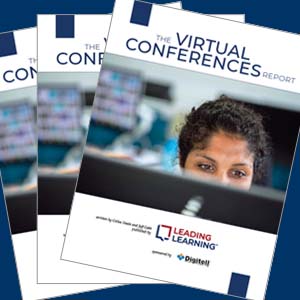The turning of a calendar from one year to the next is a natural time for reflection and preparation. In the previous episode, we looked back at the year that was for learning businesses. In this episode we turn forward to focus on the year that is.
Drawing on data collected at the end of 2021, we uncover the top areas that learning businesses are prioritizing in the new year. We also reveal three trends and two major barriers that will impact learning businesses in 2022.
To tune in, listen below. To make sure you catch all future episodes, be sure to subscribe via RSS, Apple Podcasts, Spotify, Stitcher Radio, iHeartRadio, PodBean, or any podcatcher service you may use (e.g., Overcast). And, if you like the podcast, be sure to give it a tweet.
Listen to the Show
Access the Transcript
Download a PDF transcript of this episode’s audio.
Read the Show Notes
[00:23] – Intro
Survey Says… Top 7 Areas of Focus for Learning Businesses in the Coming Year
[00:58] – To help us focus on the year that is and the opportunities and challenges for learning, we’ll draw on data we collected via an online survey in late October and early November 2021.
We received qualifying responses from 58 organizations and had supplemental exchanges with seven survey respondents. We’re grateful to everyone who participated in the survey, and we especially want to thank those who made time for the follow-on exchange:
- Nancy Bacon (Nancy Bacon Consulting)
- Karen Caldwell (SUNY Potsdam)
- Gayle Claman (American Society of Civil Engineers)
- Jack Coursen (American Speech-Language-Hearing Association)
- Mona Johnson (International Society of Amyloidosis)
- Silvia Schroeder (BildungsLAB Hands & Minds Learning Center)
- Scarlett Winters (ACUI)
We asked survey respondents to let us know which of 14 areas of activities they’re already pursuing, planning to pursue in the year ahead, or not planning to pursue.
- Creation of learning experiences that combine online elements with face-to-face elements
- Implementation of technologies that leverage artificial intelligence to support or enhance learning
- Microlearning opportunities
- Providing a personalized learning experience
- Creation of social or peer-to-peer learning experiences
- Use of virtual reality or augmented reality to provide new learning experiences or enhance existing experiences
- Use of virtual conferences (and we defined a virtual conference as an online event similar to a traditional face-to-face conference, not just a single Webinar)
- New or alternative approaches to credentialing, including certificate programs, microcredentials, and digital badges
- Aligning offerings with specific career or job paths relevant to learners—e.g., through a competency model, learning pathways, or targeted curricula
- Integration of educational offerings into the learning and development programs of employers in a field or industry or into general workforce development needs
- Development of strategies or tactics to help combat declining enrollments, downward price pressure, or “commoditization” of educational offerings
- Increased efforts to gather and analyze data to inform new product decisions or improve existing products
- Increased efforts to gather and analyze data that demonstrates the impact or effectiveness of the learning experiences offered
- Implementation of methods to ensure that learning is retained and applied over time
[03:52] – There are obviously other areas we could have asked about, so it’s important to share how we arrived at these 14.
We asked about the same 14 areas in a 2020 end-of-year survey. We developed the list back in 2018, when it contained 15 items, the 15th being one about the use of blockchain as an approach to managing learner records, which we dropped when it became clear that almost nobody was even thinking about it.
To develop the list originally, we took a modified crowdsourcing approach. We first reached out to thoughtful, smart people, practitioners and experts, those working in learning businesses and the vendors and consultants working with them, and we generated a list of trends. Folding in our own observations and thoughts, we arrived at the list of 15 originally, 14 now.
Pause for a moment to think about your priorities. What’s top of the list for your learning business to tackle this year? Your priorities might include one or more of the 14 areas we mentioned, or they might deal with other areas.
[05:52] – Seven areas are either being pursued or planning to be pursued in 2022 by roughly 75 percent or more of responding organizations.
1. Creation of learning experiences that combine online elements with face-to-face elements (92.4 percent)
We see COVID’s impact here and in the growing prevalence of blended learning among organizations. People are trying to figure out the relationship between their face-to-face offerings and their online offerings and how that’s going to play out going forward.
2. Increased efforts to gather and analyze data to inform new product decisions or improve existing products (91.5 percent)
We are big proponents of the power of big-picture marketing that goes far beyond just promotion and really starts with product development. (Listen to episode 191, “The 4 Ps of Marketing Your Learning Business,” for more on this topic.)
[07:24] –
3. Microlearning opportunities (86.5 percent)
While microlearning isn’t new, it may finally be hitting maturity, and it has the ability to speak well to some of the current moment’s realities:
- Microlearning can address Zoom fatigue and virtual burnout.
- Microlearning gives learning businesses the chance to offer something at a lower price point on their Value Ramp™.
Listen to episode 132, “8 Tips for Optimizing Your Value Ramp.” Also, check out the video below to learn more about how the Value Ramp works.
There’s an opportunity with microlearning, but I think that learning businesses are going to need to get good at microlearning to really capitalize on the opportunity. You really need to understand how to chunk content and how to craft an actual learning experience that can take place in a short time and figure out a strategy for microlearning and how it fits in your portfolio of offerings.
Celisa Steele
4. Anti-commoditization efforts (76.6 percent)
Commoditization concerns and downward price pressures aren’t new. But, over the course of 2021, COVID pumped up the amount of online learning available and the number of virtual conferences, so more learning business are trying to figure out how to do online learning and virtual conferences really well and/or how to take a unique approach so they stand out and don’t become a commodity that learners choose—or don’t choose—solely based on price.
5. Use of virtual conferences (76.4 percent)
Most organizations have had the chance to try virtual conferences by now. Some are unconvinced of the value and/or counting on being able to return to relying on in-person conferences. But we think that any organization that offers conferences should probably have some virtual conferences in the mix going forward.
Download a free copy of our Virtual Conferences Report, designed for decision-makers who want leading-edge knowledge to support their strategic planning for virtual conferences.
[11:37] –
6. Creation of social or peer-to-peer learning experiences (74.5 percent)
A focus on social and peer-to-peer learning makes great sense in the context of 2022. Social learning is incredibly effective, and the pandemic deprived many of us of some of our usual social interactions. So, in this moment, social and peer-to-peer learning are doubly appealing—they can be effective learning approaches, and, if they provide learners with some connection to others, that’s an added benefit.
7. Increased efforts to gather and analyze data that demonstrates the impact or effectiveness of the learning experiences we offer (74.4 percent)
New Professional Development Offerings from Us
[12:55] – As you’re planning for the year ahead, here are two new options for you to consider.
To help learning businesses, Leading Learning offers a range of complimentary educational resources, including this podcast. Leading Learning’s parent company, Tagoras, provides in-depth, customized consulting services to help learning businesses assess their markets, formulate strategy, and select appropriate technologies. We’ve provided relatively little between these two options historically. In 2022, we aim to change that with the launch of two new offerings.
- If you’re looking for a practical, concrete way to help your presenters to deliver more effective, impactful learning experiences, we have a course called “Presenting for Impact” that can help you do just that.
- If you’re looking for a structured, intentional way to make your learning businesses perform better, the Maturity Accelerator Program is designed to help organizations effectively leverage the Tagoras Learning Business Maturity Model in a way that aligns with their specific situation and needs.
If you’re interested in either or both of these professional development offerings, you can read more about the “Presenting for Impact” course and the Maturity Accelerator Program. Or you can always drop us a note at leadinglearning@tagoras.com.
Three Trends for the Year to Come
[14:18] – Learning businesses that embrace three trends—and act on them—will be well positioned for 2022 and beyond.
1. Greater expectations from learners
The pandemic accelerated a trend that has been in progress for years. COVID added more and more online content, and online content is inherently more accessible to a broader audience. That means your learners have more options than ever, and your learning business has more competitors than ever. You’ll have to do more to stand out and be heard in the increasingly noisy learning landscape.
Many organizations made quick pivots and took stopgap measures in 2020 and 2021, as they had to. But while those stopgap measures and shortcuts may have been acceptable or at least understandable—your customers and members were willing to put up with them during the extraordinary times of an emerging pandemic—there’s a lot less tolerance for subpar stuff as we move forward. You’re going to need to evaluate how you’re going to meet these greater expectations.
Jeff Cobb
2. The intentionality imperative
To respond to the greater expectations that learners have, a learning business needs to be more intentional, at all levels of the learning business, from high-level strategy to specific products—we have to be intentional about what we’re designing and developing and how we’re delivering it.
Arguably all of the top 7 areas of focus for learning businesses per the survey data we shared speak to getting more intentional. We also heard a lot about increased intentionality in the open-ended comments from survey respondents and in the supplemental exchanges we had.
[18:57] –
3. The great rebalancing
The pandemic pushed many individuals and organizations out of balance. Many went into survival mode. With a focus on intentionality, though, we predict a rebalancing. The rebalancing will mean portfolio changes. The goal is to rebalance to use each modality and format for its strengths and combine strength with strength for the most effective, powerful learning experience.
Here are some areas that are likely to need rebalancing in many organizations’ portfolios:
- Face-to-face versus online
This involves getting clearer on why to gather in person and probably means doing so for some purpose that can’t be readily replicated online. - Asynchronous versus synchronous
There are benefits to the freedom of asynchronous offerings and benefits to the built-in accountability of synchronous. - Broadcast versus participatory
Most organizations need to offer both content and opportunities for learners to engage with, add to, and use that content. - Personalized learning versus prescribed pathways
Many organizations have work to do to determine how much to dictate and how much to leave for open-ended, learner-driven discovery. The question of how much to personalize and how much to prescribe can be especially tricky in highly regulated fields. - Meetings versus education
The meetings-versus-education tension predates the pandemic, but the pandemic exacerbated it. Many learning businesses offer both meetings and conferences on the one hand and educational products like courses on the other. Often different groups in the organization manage those separately. Historically, for many organizations, the meetings and conferences were in person. COVID moved those online. Learners are sometimes left trying to sort out the difference between an online course and a conference session recording on the same topic. If learning businesses don’t figure that out, if they don’t help learners understand the options, then they risk cannibalization—a learner who historically went to the annual meeting and bought some online courses may wind up doing one or the other, but not both.
When the concern around cannibalization is raised, it’s usually in the context of worrying that a virtual conference will hurt in-person attendance, if you offer both in-person and virtual. A lot of data exists that shows that kind of cannibalization is a myth, but we believe virtual event content could cannibalize online course content if learning businesses don’t do the work to become more intentional about what they’re offering and do the work to rebalance.
As a silver-lining from the pandemic, we are seeing organizations do more cross-departmental work, so both meetings and education people are getting together to talk about technology or discuss a content strategy—and that needs to continue.
Barriers: People and Technology
[23:12] – We didn’t ask about barriers explicitly in the online survey, but in the follow-on exchanges we asked the folks we spoke with about barriers they’re hitting or anticipate hitting as they try to pursue their plans for 2022. In almost all of those exchanges, the answer boils down to one word: capacity. More specifically, technology and people.
On the technology side, learning businesses often have a specific vision and need but struggle to find the right technology at the right price point to support their vision.
On the people side, we’re experiencing what’s being called the Great Resignation. Many learning businesses are dealing with being down a team member or two, so they’re struggling to do everything with fewer resources, and then, of course, there’s fierce competition as they look to hire in team members with the needed skills, knowledge, and mindset.
There’s going to be a focus both on technology and people as learning businesses try to get the right pieces in place to be more intentional and to do the rebalancing work that will be critical to their success in 2022 and beyond.
To learn more about capacity, listen to episode 285, “Who and What: The Capacity Challenge.”

Here’s another place to pause and think about your own learning business. What barriers are you hitting—or do you anticipate hitting—as you try to deliver on your plans for the year ahead?
Being forewarned is being forearmed. If you know what challenges you’re likely to encounter, then you’ll be better able to deal with them when and if they arise.
[25:59] – Wrap-up
To make sure you don’t miss new episodes, we encourage you to subscribe via RSS, Apple Podcasts, Spotify, Stitcher Radio, iHeartRadio, PodBean, or any podcatcher service you may use (e.g., Overcast). Subscribing also helps us get some data on the podcast.
We’d also be grateful if you would take a minute to rate us on Apple Podcasts at https://www.leadinglearning.com/apple. We personally appreciate it and reviews and ratings help the podcast show up when people search for content on leading a learning business.
Finally, consider following us and sharing the good word about Leading Learning. You can find us on Twitter, Facebook, and LinkedIn.
Episodes on Related Topics:




 The 2022 Learning Business Landscape
The 2022 Learning Business Landscape
Leave a Reply